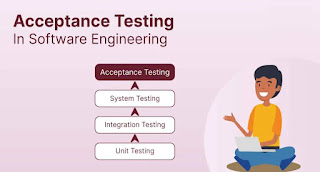Software Acceptance Testing: Ensuring Quality and User Satisfaction
Software acceptance testing plays a critical role in validating whether a product meets business requirements and is ready for deployment. It is the final stage of testing before a software product is released, ensuring that the application aligns with user expectations and performs as intended. In this blog post, we’ll explore the fundamentals of acceptance testing, its types, process, and how it benefits both developers and end users.
What is Software Acceptance Testing?
Acceptance testing is a level of software testing where the
system is evaluated for compliance with business requirements. Its primary
objective is to verify whether the software meets the acceptance criteria
defined by stakeholders. This testing serves as the final validation step
before deployment, providing assurance that the product is ready for production
use.
At its core, acceptance testing focuses on end-user
satisfaction and functionality, ensuring that the application is not only
operational but also meets the expectations of clients and stakeholders.
Types of Acceptance Testing
Different types of acceptance testing cater to specific
aspects of validation and verification:
1. User Acceptance Testing (UAT)
User acceptance testing is performed by end users or clients
to validate that the software meets their needs and functions as expected in
real-world scenarios. This type of testing focuses on usability, business
workflows, and feature correctness.
2. Operational Acceptance Testing (OAT)
Operational acceptance testing ensures that the software is
operationally ready. It involves testing aspects like backup, recovery,
failover procedures, and system performance under production conditions.
3. Regulatory Acceptance Testing
Regulatory testing ensures that the software complies with
industry regulations, legal requirements, and standards. This is particularly
crucial in industries like healthcare, finance, and telecommunications.
4. Contract and Compliance Testing
This type of testing verifies that the software adheres to
the contractual agreements and compliance obligations specified by the client
or organization.
The Acceptance Testing Process
A structured approach ensures that acceptance testing is
comprehensive and effective. Here’s an outline of the process:
- Requirement
Analysis
Teams begin by reviewing and understanding business requirements and user needs. These requirements form the foundation of the acceptance criteria. - Test
Plan Development
A detailed test plan is created, outlining the scope, objectives, test cases, and scenarios to be tested. - Environment
Setup
A production-like test environment is set up to replicate real-world conditions as closely as possible. - Execution
Tests are executed using predefined scenarios to identify discrepancies, bugs, or unmet requirements. - Feedback
and Sign-off
Results are reviewed with stakeholders, and necessary fixes are implemented. Once all issues are resolved, the product is approved for deployment.
Tools for Acceptance Testing
Modern tools can significantly enhance the efficiency and
accuracy of acceptance testing. Some popular options include:
- TestRail:
For managing test cases and results.
- Zephyr:
An agile test management tool integrated with JIRA.
- QAComplete:
A comprehensive test management solution.
Using these tools enables better traceability, automation,
and reporting, making the acceptance testing process seamless and productive.
Benefits of Acceptance Testing
Incorporating acceptance testing into the software
development lifecycle offers several advantages:
- Risk
Reduction: It minimizes the chances of post-release failures.
- Improved
User Satisfaction: Validates that the software meets user
expectations, enhancing trust and adoption.
- Business
Alignment: Ensures that the application aligns with business goals and
requirements.
- Deployment
Readiness: Confirms that the software is ready for production use
without any critical issues.
Challenges in Acceptance Testing
Despite its benefits, acceptance testing presents challenges
that teams must address:
- Unclear
Requirements: Vague or incomplete requirements can hinder effective
testing.
- Resource
Constraints: Limited time, budget, or skilled testers can impact the
process.
- User
Involvement: Engaging end users for UAT can be difficult due to
scheduling conflicts.
- Environment
Setup: Creating a realistic test environment can be complex and
time-consuming.
Best Practices for Effective Acceptance Testing
Adopting best practices can ensure the success of acceptance
testing efforts:
- Involve
Stakeholders Early: Engage clients and stakeholders from the
requirement-gathering phase.
- Define
Clear Acceptance Criteria: Establish measurable and unambiguous
criteria for success.
- Leverage
Automation Tools: Use tools to automate repetitive tasks and improve
efficiency.
- Iterate
and Improve: Continuously review and refine the testing process based
on feedback.
Real-World Examples of Acceptance Testing
Acceptance testing has proven its value across various
industries:
- E-commerce
Application: User acceptance testing revealed a critical issue in the
checkout process, preventing a potential loss in sales.
- Banking
Software: Operational acceptance testing ensured robust failover
mechanisms, maintaining reliability during peak traffic.
Conclusion
Software acceptance testing is an indispensable step in
delivering high-quality, user-centric applications. By validating business
requirements, ensuring operational readiness, and prioritizing user
satisfaction, acceptance testing minimizes risks and guarantees deployment
success. For teams aiming to enhance their software quality, integrating
acceptance testing into the software development lifecycle is essential.




Comments
Post a Comment